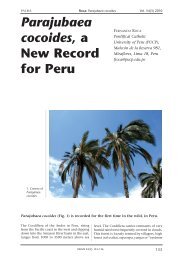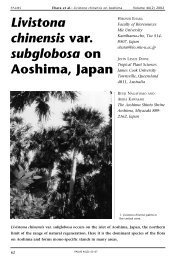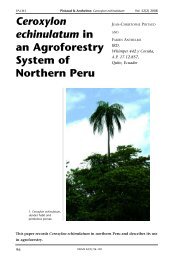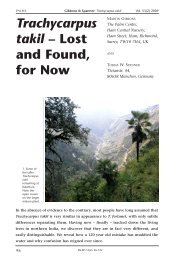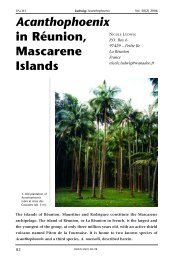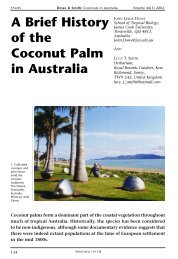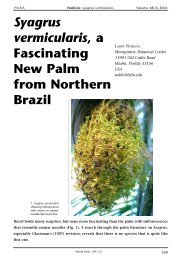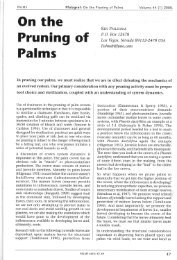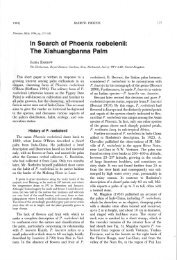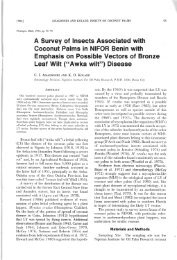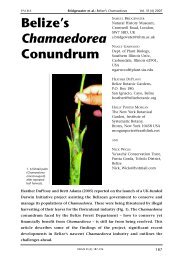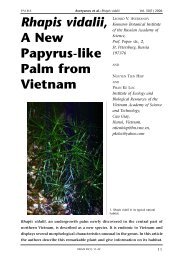Exploring for Palms in Fiji - International Palm Society
Exploring for Palms in Fiji - International Palm Society
Exploring for Palms in Fiji - International Palm Society
You also want an ePaper? Increase the reach of your titles
YUMPU automatically turns print PDFs into web optimized ePapers that Google loves.
PALMS Hodel: <strong>Fiji</strong>an <strong><strong>Palm</strong>s</strong> Vol. 55(4) 2011<br />
<strong>Explor<strong>in</strong>g</strong><br />
<strong>for</strong> <strong><strong>Palm</strong>s</strong><br />
<strong>in</strong> <strong>Fiji</strong><br />
DONALD R. HODEL<br />
University of Cali<strong>for</strong>nia<br />
Cooperative Extension<br />
4800 E. Cesar Chavez Ave.<br />
Los Angeles, CA 90022 USA<br />
drhodel@ucdavis.edu<br />
1. Large, mostly undivided<br />
leaves characterize<br />
Cyphosperma tanga.<br />
I traveled to <strong>Fiji</strong> <strong>in</strong> October, 2008 as part of a larger, long-term project to document<br />
and photograph palms on Pacific islands. Somewhat apprehensive as I departed<br />
Los Angeles on the non-stop, late-night flight to Nadi, <strong>Fiji</strong>, I had visited these<br />
delightful islands several times <strong>in</strong> the middle 1970s and was now profoundly<br />
curious about the changes that the more than 30 <strong>in</strong>terven<strong>in</strong>g years had brought.<br />
PALMS 55(4): 161–175<br />
161
PALMS Hodel: <strong>Fiji</strong>an <strong><strong>Palm</strong>s</strong> Vol. 55(4) 2011<br />
Sakiusa Masitoqui, employed at the University<br />
of the South Pacific <strong>in</strong> Suva, the capital of <strong>Fiji</strong>,<br />
and who goes by the nickname Masi, met me<br />
at the Nadi <strong>International</strong> Airport early <strong>in</strong> the<br />
morn<strong>in</strong>g on October 1 and, over a quick<br />
<strong>in</strong>troduction and breakfast, we briefly<br />
discussed plans <strong>for</strong> the next 18 days. We<br />
planned to spend several days based on the<br />
ma<strong>in</strong> <strong>Fiji</strong>an island, Viti Levu, and then move<br />
on to the two other large islands, Vanua Levu<br />
and Taveuni, be<strong>for</strong>e f<strong>in</strong>ish<strong>in</strong>g up with a trip to<br />
the Southern Lau group of islands to see the<br />
elusive Pritchardia thurstonii on mushroomshaped,<br />
limestone islets <strong>in</strong> its lagoon habitat.<br />
Masi has great knowledge of <strong>Fiji</strong>an palms,<br />
places and people and had assisted others <strong>in</strong><br />
their quest to see <strong>Fiji</strong>’s palms.<br />
I rented a 4-wheel drive pick-up truck <strong>in</strong> Nadi,<br />
and we began what I thought would be a<br />
rather leisurely, several-hour, circular drive<br />
along the north coast to Suva on the other<br />
side of Viti Levu. Under threaten<strong>in</strong>g skies <strong>in</strong> Ba,<br />
north of Nadi, we stopped briefly to eat lunch<br />
and purchase a machete, rope, and a few other<br />
supplies. After lunch, Masi surprised me and<br />
said that his plan was <strong>for</strong> us to traverse the<br />
mounta<strong>in</strong>ous center of Viti Levu via<br />
Nadarivatu and Monasavu Dam to reach Suva,<br />
rather than follow the coastal route. Travers<strong>in</strong>g<br />
the center of Viti Levu would enable us to see<br />
several strik<strong>in</strong>g palms, some of which are<br />
found nowhere else <strong>in</strong> <strong>Fiji</strong>, <strong>in</strong>clud<strong>in</strong>g<br />
Cyphosperma tanga (affectionately known as<br />
“Big Leaf”) and Physokentia petiolata. Although<br />
I was exhausted from the all night flight, Masi’s<br />
plan excited me because it had been 30 years<br />
s<strong>in</strong>ce I had last seen Big Leaf <strong>in</strong> 1978 <strong>in</strong> the<br />
company of the late Dick Phillips, long-time<br />
champion of <strong>Fiji</strong>an palms, and the late Ken<br />
Foster, palm enthusiast and <strong>for</strong>mer president<br />
of the <strong>International</strong> <strong>Palm</strong> <strong>Society</strong>. The<br />
excitement of see<strong>in</strong>g Big Leaf just a few hours<br />
after stepp<strong>in</strong>g off the plane <strong>in</strong> <strong>Fiji</strong> helped to<br />
keep me awake as I drove the vehicle off the<br />
ma<strong>in</strong> highway and headed up a smaller,<br />
mounta<strong>in</strong> road to Nadarivatu <strong>in</strong> a steady ra<strong>in</strong>.<br />
After 30 years the road up the western<br />
escarpment of Viti Levu to Nadarivatu was still<br />
familiar and, feel<strong>in</strong>g confident, I thought I<br />
could nearly drive right to Big Leaf. After<br />
pass<strong>in</strong>g through Nadarivatu under threaten<strong>in</strong>g<br />
skies, we left the road and drove up a muddy<br />
track that I was sure I had walked 30 years<br />
be<strong>for</strong>e. I was th<strong>in</strong>k<strong>in</strong>g that this little trek was<br />
go<strong>in</strong>g to be easy. Un<strong>for</strong>tunately, the road<br />
seemed to end abruptly and unexpectedly, and<br />
the much disturbed vegetation no longer<br />
looked familiar to me. Even Masi, who had<br />
2 (left). Cyphosperma tanga has an open, few branched <strong>in</strong>florescence. 3 (right). Stam<strong>in</strong>ate flowers of<br />
Cyphosperma tanga are white.<br />
162
PALMS Hodel: <strong>Fiji</strong>an <strong><strong>Palm</strong>s</strong> Vol. 55(4) 2011<br />
4 (above, left). Veitchia vitiensis is a moderate to tall, very slender palm with gracefully spread<strong>in</strong>g, p<strong>in</strong>nate<br />
leaves . 5 (above, right). Neoveitchia storckii is a large palm with long, spread<strong>in</strong>g, p<strong>in</strong>nate leaves. 6 (below).<br />
The whitish <strong>in</strong>florescences of N. storckii contrast nicely with the poorly developed but black crownshaft.<br />
visited Big Leaf just the previous year, was<br />
unable to f<strong>in</strong>d the trail. We retreated to a small<br />
farm we had just passed where, after partak<strong>in</strong>g<br />
<strong>in</strong> a brief kava ceremony and donat<strong>in</strong>g a gift,<br />
the <strong>Fiji</strong>an farmer and his two sons agreed to<br />
guide us to Big Leaf.<br />
With much anticipation and under a heavy<br />
drizzle, I followed Masi and the other <strong>Fiji</strong>ans<br />
up a rocky slope and <strong>in</strong>to wet, undisturbed,<br />
mounta<strong>in</strong> <strong>for</strong>est. Big Leaf had not lost its<br />
grandeur and with its large, undivided leaves<br />
looked every bit as impos<strong>in</strong>g as 30 years ago<br />
(Fig. 1). Big Leaf has a slender, solitary trunk<br />
three to five meters feet tall and large, elongate,<br />
undivided or few-divided leaves three meters<br />
long with short petioles. The <strong>in</strong>florescence,<br />
about one to two meters long, is loosely<br />
branched (Fig. 2) and at the moment was<br />
carry<strong>in</strong>g small, white stam<strong>in</strong>ate flowers (Fig. 3).<br />
Grow<strong>in</strong>g nearby were the highly variable,<br />
mostly understory Balaka longirostris and<br />
Veitchia vitiensis, which we would encounter<br />
later on Viti Levu. (For a complete, fully<br />
illustrated account of B. longirostris and all<br />
other Balaka <strong>in</strong> <strong>Fiji</strong> and Samoa, see Hodel<br />
2010).<br />
163
PALMS Hodel: <strong>Fiji</strong>an <strong><strong>Palm</strong>s</strong> Vol. 55(4) 2011<br />
7 (above). Hydriastele vitiensis, which covered valleys,<br />
slopes, and ridges, thrusts its spectacular canopy of<br />
arch<strong>in</strong>g, slightly recurved, p<strong>in</strong>nate leaves well above<br />
the <strong>for</strong>est trees. 8 (below). Heterospathe phillipsii is a<br />
slender, moderate, p<strong>in</strong>nate-leaved palm.<br />
After say<strong>in</strong>g thanks and goodbye to our <strong>Fiji</strong>an<br />
guides, Masi and I returned to the road and<br />
headed east from Nadarivatu toward<br />
Monasavu Dam <strong>in</strong>to what was <strong>for</strong> me<br />
uncharted territory. In the middle 1970s the<br />
road ended not too far east of Nadarivatu, and<br />
only a foot track cont<strong>in</strong>ued across the center<br />
of Viti Levu. The construction of Monasavu<br />
Dam <strong>in</strong> the 1980s pushed a road through to<br />
the dam site and then down the eastern<br />
escarpment of Viti Levu to Suva. The unpaved<br />
road was of poor quality, muddy, with stand<strong>in</strong>g<br />
pools of water and deep ruts, but with careful<br />
driv<strong>in</strong>g we were able to negotiate its<br />
treacherous meander<strong>in</strong>gs. Our goals at<br />
Monasavu Dam were Cl<strong>in</strong>ostigma exorrhizum<br />
and Physokentia petiolata, which Masi knew<br />
were along an access road to the dam.<br />
When we arrived at the dam late <strong>in</strong> the<br />
afternoon, aga<strong>in</strong> under threaten<strong>in</strong>g skies, the<br />
work and guard stations were deserted, and,<br />
un<strong>for</strong>tunately, we needed a key to access the<br />
road to the dam. Under a heavy drizzle we<br />
waited <strong>in</strong> the car, chatt<strong>in</strong>g, read<strong>in</strong>g, and<br />
snack<strong>in</strong>g until dusk approached. With much<br />
disappo<strong>in</strong>tment we f<strong>in</strong>ally gave up and<br />
decided to cont<strong>in</strong>ue on to Suva. Just as we<br />
were depart<strong>in</strong>g some workers arrived and<br />
unlocked the gate <strong>for</strong> us. However, because it<br />
was so late, darkness was fast approach<strong>in</strong>g, and<br />
we still had several hours of rough travel<br />
rema<strong>in</strong><strong>in</strong>g, we made arrangements to return to<br />
164
PALMS Hodel: <strong>Fiji</strong>an <strong><strong>Palm</strong>s</strong> Vol. 55(4) 2011<br />
Monasavu Dam <strong>in</strong> several weeks at the end of<br />
my <strong>Fiji</strong>an sojourn.<br />
The rema<strong>in</strong><strong>in</strong>g drive down the eastern<br />
escarpment to Suva was an un<strong>for</strong>gettable<br />
experience. Somewhat disappo<strong>in</strong>ted from our<br />
temporary failure at the dam, and cold, wet,<br />
hungry, and with only the weak lights of our<br />
vehicle show<strong>in</strong>g the way, we cont<strong>in</strong>ued on <strong>in</strong><br />
what seemed like a never-end<strong>in</strong>g, bone-jarr<strong>in</strong>g,<br />
downward spiral <strong>in</strong>to darkness. F<strong>in</strong>ally, after<br />
what seemed like weeks but was really only<br />
four hours, the welcom<strong>in</strong>g lights of Suva<br />
appeared <strong>in</strong> the distance. I dropped Masi off<br />
at his home, drove to my hotel, showered, ate<br />
and then collapsed <strong>in</strong>to bed after 20 hours of<br />
no sleep but with contented visions of Big Leaf<br />
<strong>in</strong> my m<strong>in</strong>d.<br />
Masi and I spent the next three days on trips<br />
around the greater Suva area look<strong>in</strong>g <strong>for</strong> palms.<br />
On October 2 <strong>in</strong> the morn<strong>in</strong>g we visited Coloi-Suva<br />
Forest Park, a well known, traditional<br />
and long-popular locale <strong>for</strong> palms just a few<br />
m<strong>in</strong>utes outside of Suva, where we observed<br />
and photographed Balaka microcarpa and<br />
Veitchia vitiensis. The latter is a moderate to<br />
tall, very slender palm with gracefully<br />
spread<strong>in</strong>g, p<strong>in</strong>nate leaves (Fig. 4), a well<br />
developed and conspicuously mottled<br />
crownshaft, and small, bright red fruits.<br />
After lunch we headed to Naquali <strong>in</strong> the Rewa<br />
River valley to see Neoveitchia storckii,<br />
9 (above). Metroxylon vitiense typically grows <strong>in</strong> low,<br />
wet, sometimes swampy land. 10 (below). Veitchia<br />
filifera is a slender, moderately tall, mostly understory<br />
palm with dist<strong>in</strong>ctly ascend<strong>in</strong>g, p<strong>in</strong>nate leaves.<br />
165
PALMS Hodel: <strong>Fiji</strong>an <strong><strong>Palm</strong>s</strong> Vol. 55(4) 2011<br />
11 (left). The dark green, nearly black crownshaft of Veitchia filifera complements the whitish trunk. 12 (right).<br />
Physokentia thurstonii is a small to moderate, understory, stilt-root palm with a bright green, prom<strong>in</strong>ently and<br />
closely r<strong>in</strong>ged trunk, and conspicuous, swollen, grayish crownshaft.<br />
Metroxylon vitiense and Calamus vitiensis.<br />
Although we would see the last two species<br />
elsewhere <strong>in</strong> <strong>Fiji</strong>, it was our only opportunity<br />
to see N. storckii because of its restricted<br />
distribution, so we allocated several hours to<br />
explore wet, muddy, highly disturbed <strong>for</strong>est<br />
<strong>in</strong> search of this handsome palm. With long,<br />
spread<strong>in</strong>g, p<strong>in</strong>nate leaves, N. storckii is a large<br />
palm (Fig. 5) and has whitish <strong>in</strong>florescences<br />
that contrast nicely with the poorly developed<br />
but black crownshaft (Fig. 6). The bright red<br />
fruits are large and showy, add<strong>in</strong>g to the palm’s<br />
handsome nature. Un<strong>for</strong>tunately, there is little<br />
regeneration <strong>in</strong> this disturbed site, which is<br />
much the same <strong>in</strong> the other, highly restricted<br />
sites where Neoveitchia storckii occurs, and thus<br />
mak<strong>in</strong>g it an endangered species. Later <strong>in</strong> the<br />
afternoon on the return to Suva we stopped<br />
along the road to Mt. Nakabalevu, where we<br />
aga<strong>in</strong> saw Balaka microcarpa and Veitchia<br />
vitiensis.<br />
On the morn<strong>in</strong>g of October 3 Masi and I<br />
headed west from Suva along the southern<br />
coastal route to Nadi. At the small settlement<br />
at Nabout<strong>in</strong>i we turned north or <strong>in</strong>land <strong>in</strong>to<br />
the mounta<strong>in</strong>s along a dirt road to Nabukelevu<br />
to visit the unnamed and highly endangered,<br />
p<strong>in</strong>nate-leaved species of Cyphosperma,<br />
hereto<strong>for</strong>e known only from and by its<br />
location, Nabout<strong>in</strong>i. (For a complete and<br />
illustrated account of this new species see<br />
Hodel and Marcus, <strong>in</strong> this issue). In some ways<br />
it was like a p<strong>in</strong>nate-leaved version of Big Leaf<br />
but differed <strong>in</strong> its larger habit and lower,<br />
somewhat drier habitat. In the area we also<br />
saw scattered <strong>in</strong>dividuals of Veitchia joannis<br />
pok<strong>in</strong>g their canopies high above the<br />
surround<strong>in</strong>g vegetation.<br />
We returned to the ma<strong>in</strong> southern coastal road<br />
around Viti Levu and drove to Galoa, where<br />
once aga<strong>in</strong> we turned <strong>in</strong>land or north <strong>in</strong>to the<br />
mounta<strong>in</strong>s, this time on the road to Waibogi.<br />
In a short while we encountered vast stands of<br />
the splendid Hydriastele vitiensis, which covered<br />
valleys, slopes, and ridges, thrust<strong>in</strong>g its<br />
spectacular canopy of arch<strong>in</strong>g, slightly<br />
recurved, p<strong>in</strong>nate leaves well above the <strong>for</strong>est<br />
trees (Fig. 7). A tall palm, H. vitiensis has a well<br />
developed, brownish white, slightly swollen<br />
crownshaft and broom-like <strong>in</strong>florescences.<br />
Strangely, this abundant, conspicuous, and<br />
relatively easy-to-access palm was only<br />
166
PALMS Hodel: <strong>Fiji</strong>an <strong><strong>Palm</strong>s</strong> Vol. 55(4) 2011<br />
13 (above left). Calamus vitiensis is a climb<strong>in</strong>g rattan. 14 (above right). Leaf bases of C. vitiensis are densely<br />
sp<strong>in</strong>y. 15 (below). The handsome fruits of C. vitiensis are small, white, and densely covered with scales.<br />
discovered <strong>in</strong> the late 1970s and named <strong>in</strong><br />
1982 as Gulubia vitiensis. Balaka longirostris and<br />
Veitchia vitiensis grew nearby <strong>in</strong> the <strong>for</strong>est<br />
understory, complet<strong>in</strong>g our palm adventures<br />
<strong>for</strong> the day.<br />
October 4 found Masi and me aga<strong>in</strong> along the<br />
southern coastal route to Nadi, this time<br />
turn<strong>in</strong>g north or <strong>in</strong>land <strong>in</strong>to the mounta<strong>in</strong>s at<br />
Nabukavesi on a well ma<strong>in</strong>ta<strong>in</strong>ed but dirt road<br />
to Namosi. Veitchia vitiensis was aga<strong>in</strong> common<br />
<strong>in</strong> this wet and <strong>in</strong>trigu<strong>in</strong>g <strong>for</strong>est, and we also<br />
encountered an unusual, and at that time,<br />
unnamed species of Balaka, commonly but<br />
erroneously referred to as B. macrocarpa. In my<br />
synopsis of Balaka, which I referred to earlier,<br />
I named this species B. diffusa.<br />
Return<strong>in</strong>g to the southern coastal route, we<br />
drove to Navua, where we once aga<strong>in</strong> turned<br />
off the ma<strong>in</strong> road to the north <strong>in</strong>to the low<br />
hills on a poorly ma<strong>in</strong>ta<strong>in</strong>ed dirt road to<br />
Nakavu Village. Here we found, <strong>in</strong> highly<br />
disturbed <strong>for</strong>est thick with <strong>in</strong>vasive v<strong>in</strong>es,<br />
Heterospathe phillipsii, named <strong>in</strong> 1997 <strong>in</strong> honor<br />
of the late Dick Phillips. A slender, moderate,<br />
p<strong>in</strong>nate-leaved palm (Fig. 8), H. phillipsii lacks<br />
a crownshaft and typically carries many, much<br />
167
PALMS Hodel: <strong>Fiji</strong>an <strong><strong>Palm</strong>s</strong> Vol. 55(4) 2011<br />
branched <strong>in</strong>fructescences aris<strong>in</strong>g from among<br />
the leaf bases and hold<strong>in</strong>g the small, bright<br />
red fruits.<br />
With several hours of daylight rema<strong>in</strong><strong>in</strong>g, we<br />
returned to Suva and visited the nearby Rewa<br />
River delta area, where we photographed nice<br />
stands of Metroxylon vitiense (Fig. 9) and Veitchia<br />
joannis grow<strong>in</strong>g <strong>in</strong> low, wet, sometimes<br />
swampy land. Both are tall palms with p<strong>in</strong>nate<br />
leaves, and the robust M. vitiense, upon<br />
reach<strong>in</strong>g maturity, sends <strong>for</strong>th <strong>in</strong>florescences<br />
from the top and center of the canopy, thus<br />
signal<strong>in</strong>g the end of the life of the palm. Like<br />
all Metroxylon, the large, handsome fruits of<br />
this species are covered with attractive, sh<strong>in</strong>y<br />
scales. Veitchia joannis, which unlike<br />
Metroxylon, has a dist<strong>in</strong>ct and well developed<br />
crownshaft below which are the dense, much<br />
branched <strong>in</strong>fructescences with large, red fruits,<br />
has a slender trunk and arch<strong>in</strong>g p<strong>in</strong>nate leaves.<br />
On the morn<strong>in</strong>g of October 5 Masi and I flew<br />
to Vanua Levu Island and landed near<br />
Savusavu, where we met up with Jim<br />
Valent<strong>in</strong>e, an Australian who has a nursery<br />
and landscape bus<strong>in</strong>ess <strong>in</strong> an idyllic sett<strong>in</strong>g<br />
overlook<strong>in</strong>g picturesque Savusavu Bay. Jim<br />
would accompany us <strong>in</strong> our palm exploration<br />
on Vanua Levu and Taveuni and generously<br />
provided the use of his 4-wheel drive pick up<br />
truck. We drove straight to Lambasa on the<br />
north side of Vanua Levu, and after settl<strong>in</strong>g<br />
<strong>in</strong>to our hotel, we ate lunch and planned our<br />
activities <strong>for</strong> the next several days.<br />
The morn<strong>in</strong>g of October 6 dawned overcast<br />
with the threat of ra<strong>in</strong> but, nonetheless, we<br />
drove south from Lambasa, navigat<strong>in</strong>g a<br />
labyr<strong>in</strong>th of confus<strong>in</strong>g dirt roads, toward<br />
Matani Creek and the track up Mt. Sorolevu,<br />
an excit<strong>in</strong>g area <strong>for</strong> palms with no fewer than<br />
five genera and seven species present,<br />
<strong>in</strong>clud<strong>in</strong>g the mostly understory Veitchia filifera<br />
and Balaka “Bulitavu,” B. seemannii and B.<br />
streptostachys at lower elevations and the larger<br />
Cl<strong>in</strong>ostigma exorrhizum, Heterospathe longipes<br />
and Hydriastele vitiensis higher up.<br />
The ma<strong>in</strong> objective on Mt. Sorolevu was to see<br />
Balaka “Bulitavu” and determ<strong>in</strong>e its proper<br />
taxonomic status and correct name. In a steady<br />
ra<strong>in</strong> we drove as far as we could up the Mt.<br />
Sorolevu track be<strong>for</strong>e an immense, ugly<br />
16 (left). Cyphosperma trichospadix is a small to moderate, mostly understory palm with a slender, closely and<br />
conspicuously r<strong>in</strong>ged trunk and p<strong>in</strong>nate leaves. 17 (right). A tall, emergent species, Cl<strong>in</strong>ostigma exorrhizum has<br />
a stunn<strong>in</strong>g canopy of long, p<strong>in</strong>nate leaves with numerous, slender, elegantly pendulous p<strong>in</strong>nae.<br />
168
PALMS Hodel: <strong>Fiji</strong>an <strong><strong>Palm</strong>s</strong> Vol. 55(4) 2011<br />
washout abruptly term<strong>in</strong>ated our ascent. Jim<br />
and Masi, who had visited the area previously,<br />
had been able to drive much farther up Mt.<br />
Sorolevu but today our fate was to walk some<br />
distance <strong>in</strong> the steady ra<strong>in</strong> be<strong>for</strong>e enter<strong>in</strong>g the<br />
<strong>for</strong>est to explore <strong>for</strong> palms. The ra<strong>in</strong> <strong>in</strong>creased<br />
to a torrential downpour, <strong>for</strong>c<strong>in</strong>g me on several<br />
occasions to stand under an umbrella <strong>for</strong> five<br />
to ten m<strong>in</strong>utes at a time, camera and note pad<br />
patiently <strong>in</strong> hand, wait<strong>in</strong>g <strong>for</strong> the slightest<br />
break <strong>in</strong> the ra<strong>in</strong> to snap a few photos.<br />
Fortunately, our persistence under the most<br />
deplorable conditions enabled me to gather<br />
some good photos and determ<strong>in</strong>e that B.<br />
“Bulitavu” was actually B. macrocarpa.<br />
Although we saw a few juvenile Heterospathe<br />
longipes, the deteriorat<strong>in</strong>g conditions and<br />
cont<strong>in</strong>ued heavy ra<strong>in</strong> dampened our<br />
enthusiasm <strong>for</strong> explor<strong>in</strong>g higher up on Mt.<br />
Sorolevu to see Cl<strong>in</strong>ostigma exorrhizum and<br />
Hydriastele vitiensis, species that we had already<br />
seen or would see <strong>in</strong> other areas, so we<br />
returned to the truck and made our descent<br />
toward Lambasa.<br />
Farther down Mt. Sorolevu the ra<strong>in</strong> let up and<br />
we stopped to observe the widespread and<br />
variable Balaka seemannii and Veitchia filifera,<br />
the latter a slender, moderately tall, mostly<br />
understory palm with a whitish to brown<br />
trunk, dist<strong>in</strong>ctly ascend<strong>in</strong>g, p<strong>in</strong>nate leaves (Fig.<br />
10), and a dark green, nearly black crownshaft<br />
(Fig. 11). The relatively large, spread<strong>in</strong>g<br />
18 (above). Veitchia simulans is a moderate to tall,<br />
slender, mostly understory palm with a brownish,<br />
closely r<strong>in</strong>ged trunk, a dark green, slightly mottled<br />
crownshaft, and canopy of spread<strong>in</strong>g, p<strong>in</strong>nate<br />
leaves. 19 (below). In contrast to the other small,<br />
mostly understory Veitchia we had encountered so<br />
far, Veitchia simulans had unusually large fruits.<br />
169
PALMS Hodel: <strong>Fiji</strong>an <strong><strong>Palm</strong>s</strong> Vol. 55(4) 2011<br />
20 (left). Hydriastele boumae differs from H. vitiensis <strong>in</strong> the manner <strong>in</strong> which it reta<strong>in</strong>s large, undivided or fewsplit<br />
leaves nearly to maturity, up until it beg<strong>in</strong>s to emerge above the <strong>for</strong>est canopy, as here with Masi, who<br />
provides scale. 21 (right). Heterospathe longipes is a moderate understory palm with a slender, brownish,<br />
closely r<strong>in</strong>ged trunk and canopy of spread<strong>in</strong>g, p<strong>in</strong>nate leaves.<br />
<strong>in</strong>fructescences held the full size but not yet<br />
red-orange, ripe fruits.<br />
On October 7 Jim, Masi, and I left Lambasa<br />
under bright, sunny skies and returned to<br />
Savusavu, stopp<strong>in</strong>g at Waisali Ra<strong>in</strong><strong>for</strong>est<br />
Reserve to see Balaka seemannii and Physokentia<br />
thurstonii, the latter a small to moderate,<br />
understory, stilt-root palm with a bright green,<br />
prom<strong>in</strong>ently and closely r<strong>in</strong>ged trunk,<br />
conspicuous, swollen, grayish crownshaft (Fig.<br />
12), whitish <strong>in</strong>florescence, and curiously<br />
sculptured seeds. Stilt-root palms have always<br />
held a special fasc<strong>in</strong>ation <strong>for</strong> me, so to see and<br />
photograph P. thurstonii was an excit<strong>in</strong>g<br />
experience despite the dense vegetation<br />
mak<strong>in</strong>g photography difficult. Closer to<br />
Savusavu we stopped briefly to observe a large<br />
stand of Metroxylon vitiense <strong>in</strong> low, wet,<br />
swampy land.<br />
After Masi and I settled <strong>in</strong>to our hotel <strong>in</strong><br />
Savusavu, we ate lunch and visited Jim’s house<br />
and nursery, admir<strong>in</strong>g the many f<strong>in</strong>e plants<br />
he was grow<strong>in</strong>g <strong>for</strong> landscap<strong>in</strong>g, <strong>in</strong>clud<strong>in</strong>g<br />
numerous palms. Over d<strong>in</strong>ner we discussed<br />
plans <strong>for</strong> our last day on Vanua Levu, a trip to<br />
Natewa Pen<strong>in</strong>sula to see the unusual Balaka<br />
“Natewa” that carried large, nearly simple,<br />
undivided leaves not just <strong>in</strong> a juvenile state but<br />
nearly to maturity. I suspected this could be B.<br />
macrocarpa because this species was orig<strong>in</strong>ally<br />
collected <strong>in</strong> the area.<br />
October 8 was a bright and sunny day as we<br />
headed out southeast from Savusavu onto the<br />
Natewa Pen<strong>in</strong>sula. We stopped at several places<br />
to observe and photograph Veitchia filifera and<br />
then found a small hill abundant with what<br />
was popularly known as B. “Natewa” but,<br />
which now upon exam<strong>in</strong>ation, I could confirm<br />
it was, <strong>in</strong>deed, B. macrocarpa as we had seen<br />
also on Mt. Sorolevu. This Natewa population,<br />
though, was <strong>in</strong>trigu<strong>in</strong>g <strong>in</strong> how it carried the<br />
large, mostly undivided leaves nearly to<br />
flower<strong>in</strong>g and fruit<strong>in</strong>g.<br />
Upon return<strong>in</strong>g to Savusavu we learned the<br />
disturb<strong>in</strong>g news that one of the two <strong>Fiji</strong>an<br />
<strong>in</strong>ter-island airl<strong>in</strong>es that was to fly Masi and me<br />
170
PALMS Hodel: <strong>Fiji</strong>an <strong><strong>Palm</strong>s</strong> Vol. 55(4) 2011<br />
from Taveuni back to Suva and then on to the<br />
Southern Lau group to see Pritchardia thurstonii<br />
had temporarily shut down service, <strong>for</strong>c<strong>in</strong>g us<br />
hurriedly to purchase new tickets on the<br />
rema<strong>in</strong><strong>in</strong>g <strong>in</strong>terisland airl<strong>in</strong>e from Taveuni to<br />
Suva. Un<strong>for</strong>tunately, this airl<strong>in</strong>e did not fly to<br />
the Southern Lau group, putt<strong>in</strong>g <strong>in</strong> jeopardy<br />
our plans to visit those islands and see P.<br />
thurstonii.<br />
We departed Savusavu on the morn<strong>in</strong>g of<br />
October 9, aga<strong>in</strong> head<strong>in</strong>g onto the Natewa<br />
Pen<strong>in</strong>sula, but this time to catch the ferry to<br />
take us and Jim’s truck across the narrow strait<br />
to Taveuni Island. After a one-hour ferry ride<br />
we landed on Taveuni and drove to<br />
Somosomo, purchased food <strong>for</strong> the next<br />
several days and then settled <strong>in</strong>to our rather<br />
spartan accommodations.<br />
Although Taveuni promised to be an excit<strong>in</strong>g<br />
island <strong>for</strong> palms, our enthusiasm was<br />
somewhat tempered by the wet conditions we<br />
had encountered on Vanua Levu. Taveuni is<br />
even wetter than Vanua Levu, with some<br />
places receiv<strong>in</strong>g over n<strong>in</strong>e meters of ra<strong>in</strong><br />
annually! Fortunately, we had three, mostly<br />
sunny days on Taveuni, mak<strong>in</strong>g our stay there<br />
a productive and enjoyable time.<br />
I was especially full of excited anticipation on<br />
October 10 as we walked up the trail from<br />
Somosomo to the Crater Lakes, long a classical<br />
and fabled locale with a rich assemblage of<br />
palms, <strong>in</strong>clud<strong>in</strong>g Balaka seemannii, Calamus<br />
vitiensis, Cl<strong>in</strong>ostigma exorrhizum, Cyphosperma<br />
trichospadix, Physokentia thurstonii and Veitchia<br />
simulans. On this sunny day the <strong>for</strong>est was<br />
breathtak<strong>in</strong>g, vibrant and exuberant with a<br />
rich mixture of palms, shrubs, and trees, many<br />
support<strong>in</strong>g a rich and heavy load of epiphytic<br />
mosses, ferns, orchids and aroids. The first<br />
palm we encounter was the sp<strong>in</strong>y, climb<strong>in</strong>g<br />
rattan C. vitiensis (Figs. 13–15), which seemed<br />
well adapted to survival <strong>in</strong> lower, open,<br />
disturbed areas as well as <strong>in</strong> mostly<br />
undisturbed <strong>for</strong>est. Its small, scaly, whitish<br />
fruits were unusually attractive (Fig. 15). Aga<strong>in</strong>,<br />
the widespread and variable understory B.<br />
seemannii was <strong>in</strong> abundance and was especially<br />
conspicuous with open clusters of showy, red<br />
fruits. Farther on <strong>in</strong> the <strong>for</strong>est we soon<br />
encountered the stilt-rooted Physokentia<br />
thurstonii, which we had seen earlier on Vanua<br />
Levu, and Cyphosperma trichospadix, a small to<br />
moderate, mostly understory palm with a<br />
slender, closely and conspicuously r<strong>in</strong>ged<br />
trunk and p<strong>in</strong>nate leaves (Fig. 16). A more<br />
dim<strong>in</strong>utive palm than C. nabout<strong>in</strong>ense and<br />
22. The especially showy and fragrant, bright red fruits of Heterospathe longipes are held on short<br />
<strong>in</strong>fructescences that arise from among the deeply split leaf bases.<br />
171
PALMS Hodel: <strong>Fiji</strong>an <strong><strong>Palm</strong>s</strong> Vol. 55(4) 2011<br />
23. Be<strong>for</strong>e weather<strong>in</strong>g away, trunks of Cl<strong>in</strong>ostigma<br />
exorrhizum are covered with white, powdery wax.<br />
even C. tanga, it nonetheless has the same<br />
deeply split, green leaf bases that do not <strong>for</strong>m<br />
a crownshaft and from which the few<br />
branched <strong>in</strong>florescences arise.<br />
A little farther on we began to see Cl<strong>in</strong>ostigma<br />
exorrhizum, a tall, emergent species with an<br />
attractive, smooth but r<strong>in</strong>ged, whitish green to<br />
brown trunk supported on a cone of thick,<br />
robust stilt roots, a well developed elongate,<br />
greenish crownshaft, and a stunn<strong>in</strong>g canopy<br />
of long, p<strong>in</strong>nate leaves with numerous, slender,<br />
elegantly pendulous p<strong>in</strong>nae (Fig. 17). Many<br />
short-branched <strong>in</strong>florescences <strong>in</strong> all stages of<br />
flower and fruit were held just below the<br />
crownshaft and were particularly showy when<br />
heavily laden with small, red fruits.<br />
As we made our late-afternoon return down<br />
the trail to Somosomo, we stopped to admire<br />
and photograph Veitchia simulans, a rather shy,<br />
moderate to tall, slender, mostly understory<br />
palm with a brownish, closely r<strong>in</strong>ged trunk, a<br />
dark green, slightly mottled crownshaft, and<br />
canopy of spread<strong>in</strong>g, p<strong>in</strong>nate leaves (Fig. 18).<br />
In contrast to the other small, mostly<br />
understory Veitchia we had encountered so far,<br />
this species had unusually large fruits although<br />
not as large as those of V. joannis (Fig. 19).<br />
On October 11 we drove to the southeast side<br />
of Taveuni to make a trek <strong>in</strong>to the Vidawa Ra<strong>in</strong><br />
Forest Walk, reputed to be one of the wettest<br />
places <strong>in</strong> <strong>Fiji</strong>, but that featured many f<strong>in</strong>e<br />
palms, <strong>in</strong>clud<strong>in</strong>g Balaka seemannii, Calamus<br />
vitiensis, Heterospathe longipes, Hydriastele<br />
boumae and Veitchia filifera. With sunny,<br />
cooperative weather, we checked <strong>in</strong> at the<br />
park’s headquarters, paid our entrance fee and<br />
hired the required <strong>Fiji</strong>an guide to take us up<br />
<strong>in</strong>to the <strong>for</strong>est. The first palm we encountered<br />
and the most abundant and widespread was H.<br />
boumae, which, like its close relative on Vanua<br />
Levu and Viti Levu, H. vitiensis, was an<br />
emergent species with a tall, brownish trunk,<br />
conspicuous, swollen, whitish crownshaft,<br />
canopy of arch<strong>in</strong>g, recurved, p<strong>in</strong>nate leaves,<br />
and broom-like <strong>in</strong>florescences (Back Cover).<br />
Its most unusual but strik<strong>in</strong>g feature, and one<br />
of its dist<strong>in</strong>guish<strong>in</strong>g characters, was the<br />
manner <strong>in</strong> which it reta<strong>in</strong>ed large, undivided<br />
or few-split leaves nearly to maturity, up until<br />
it began to emerge above the <strong>for</strong>est canopy<br />
(Fig. 20).<br />
Heterospathe longipes, a moderate understory<br />
palm with a slender, brownish, closely r<strong>in</strong>ged<br />
trunk and canopy of spread<strong>in</strong>g, p<strong>in</strong>nate leaves,<br />
was locally common (Fig. 21). It has deeply<br />
split leaf bases that do not <strong>for</strong>m a crownshaft<br />
but from which the relatively short, heavy, few<br />
branched <strong>in</strong>florescences arise. These hold the<br />
whitish stam<strong>in</strong>ate and pistillate flowers and<br />
later the large, especially showy and fragrant,<br />
red fruits (Fig. 22). Un<strong>for</strong>tunately, many of the<br />
leaves showed extensive and severe<br />
skeletoniz<strong>in</strong>g from an unknown pest.<br />
Our last day on Taveuni, October 12, was spent<br />
along the road to the summit of Des Voeux<br />
Peak, another traditional locale <strong>for</strong> palms.<br />
Under foggy but not ra<strong>in</strong>y conditions we<br />
observed many f<strong>in</strong>e specimens of Cl<strong>in</strong>ostigma<br />
exorrhizum, and here the cone of stilt roots,<br />
which supported the handsome, greenish<br />
brown, r<strong>in</strong>ged trunk with a heavy, white waxy<br />
glaucous cover<strong>in</strong>g (Fig. 23), was unusually well<br />
developed (Fig. 24). On some <strong>in</strong>dividuals the<br />
cone of stilt roots reached nearly two meters<br />
up the trunk and spread <strong>for</strong> well over two<br />
meters at the base. The large, thick, robust<br />
172
PALMS Hodel: <strong>Fiji</strong>an <strong><strong>Palm</strong>s</strong> Vol. 55(4) 2011<br />
roots emerged bright orange, their enlarged<br />
tips capped with a mossy glove, be<strong>for</strong>e ag<strong>in</strong>g<br />
to the more common brown. Close by were a<br />
few specimens of Veitchia simulans, a species<br />
that we had seen several days earlier on the<br />
trail from Somosomo to Crater Lakes. As we<br />
descended Des Voeux Peak the ra<strong>in</strong> began <strong>in</strong><br />
earnest and we felt <strong>for</strong>tunate to have had three<br />
days of mostly f<strong>in</strong>e weather <strong>in</strong> one of <strong>Fiji</strong>’s<br />
ra<strong>in</strong>iest places.<br />
On October 13 Masi and I said our good byes<br />
and thanks to Jim <strong>for</strong> his admirable<br />
companionship and help <strong>in</strong> the field, and we<br />
boarded our plane <strong>for</strong> the flight back to Suva.<br />
Upon arrival <strong>in</strong> Suva we immediately and<br />
persistently tried to make new arrangements<br />
to travel to the Southern Lau group to see<br />
Pritchardia thurstonii. Un<strong>for</strong>tunately, it became<br />
<strong>in</strong>creas<strong>in</strong>gly clear that a trip to the Southern<br />
Lau group was impossible to arrange <strong>for</strong> the<br />
last few days of my <strong>Fiji</strong>an stay and, with much<br />
disappo<strong>in</strong>tment, I realized my sojourn to see<br />
P. thurstonii would have to wait <strong>for</strong> another<br />
time.<br />
I spent my extra days <strong>in</strong> Suva wisely,<br />
exam<strong>in</strong><strong>in</strong>g Balaka and Cyphosperma specimens<br />
at the herbarium at the University of the South<br />
Pacific and, with Masi, visit<strong>in</strong>g public and<br />
private gardens to see cultivated specimens of<br />
exotic and <strong>Fiji</strong>an palms. The Thurston Gardens<br />
<strong>in</strong> <strong>Fiji</strong> conta<strong>in</strong>ed many f<strong>in</strong>e specimens of <strong>Fiji</strong>an<br />
and other Pacific Island palms, many planted<br />
by the late Dick Phillips, <strong>in</strong>clud<strong>in</strong>g mature,<br />
fruit<strong>in</strong>g Carpoxylon macrospermum, various<br />
Veitchia, and the Melanesian <strong>for</strong>m (smallfruited)<br />
of Pelagodoxa henryana. Another f<strong>in</strong>e<br />
collection of palms is <strong>in</strong> the small botanical<br />
gardens of the University of the South Pacific,<br />
and several places on the campus had fruit<strong>in</strong>g<br />
<strong>Fiji</strong>an palms, <strong>in</strong>clud<strong>in</strong>g Heterospathe phillipsii,<br />
Neoveitchia storckii and various Veitchia. Dick<br />
Watl<strong>in</strong>g, author of the exceed<strong>in</strong>gly handsome<br />
<strong><strong>Palm</strong>s</strong> of the <strong>Fiji</strong> Islands, has perhaps the f<strong>in</strong>est<br />
collection of <strong>Fiji</strong>an palms, <strong>in</strong>clud<strong>in</strong>g several<br />
notably specimens of Balaka, Heterospathe<br />
longipes, H. phillipsii, Metroxylon vitiense,<br />
Neoveitchia storckii and various Veitchia.<br />
One day I spent with Marika Tuiwawa, director<br />
and curator of the herbarium at the University<br />
of the South Pacific, travel<strong>in</strong>g to the west on<br />
the southern coastal route towards Nadi,<br />
stopp<strong>in</strong>g at a few places around Pacific<br />
24. Masi provides scale <strong>for</strong> this exceptional cone of orange stilt roots support<strong>in</strong>g the trunk of this Cl<strong>in</strong>ostigma<br />
exorrhizum. Note the root tips clad <strong>in</strong> their mossy “gloves.”<br />
173
PALMS Hodel: <strong>Fiji</strong>an <strong><strong>Palm</strong>s</strong> Vol. 55(4) 2011<br />
25. The conspicuous, rose-colored <strong>in</strong>florescence of Physokentia petiolata dist<strong>in</strong>guishes it from P. thurstonii.<br />
Harbour to see Metroxylon vitiensis and the<br />
widespread and variable Balaka longirostris and<br />
then visit<strong>in</strong>g Robbie Stone’s superb collection<br />
of exotic and <strong>Fiji</strong>an palms, many received from<br />
the late Dick Phillips.<br />
My stay <strong>in</strong> <strong>Fiji</strong> was fast approach<strong>in</strong>g its f<strong>in</strong>al<br />
days, and on October 18 Masi and I planned<br />
once aga<strong>in</strong> to traverse the center of Viti Levu<br />
from Suva to Nadi to return to Monasavu Dam<br />
to see Cl<strong>in</strong>ostigma exorrhizum and Physokentia<br />
petiolata be<strong>for</strong>e my late night departure to Los<br />
Angeles on October 19. Around midnight on<br />
October 17 I was awakened by a strong, steady<br />
ra<strong>in</strong>, which by morn<strong>in</strong>g had turned <strong>in</strong>to a<br />
torrential downpour, easily one of the heaviest<br />
ra<strong>in</strong>s I had ever experienced. I was sure that our<br />
trip through the center of Viti Levu would<br />
have to be cancelled and I would be return<strong>in</strong>g<br />
to Los Angeles without see<strong>in</strong>g all the palms I<br />
had <strong>in</strong>tended to see. However, when Masi<br />
arrived at the hotel early <strong>in</strong> the morn<strong>in</strong>g of<br />
October 18 he assured me that we should still<br />
make an attempt across the center of Viti Levu!<br />
I was stunned and much less confident than<br />
Masi, but nonetheless, we set out <strong>in</strong> a driv<strong>in</strong>g<br />
ra<strong>in</strong>, negotiat<strong>in</strong>g flooded streets as we made<br />
our way through a nearly deserted Suva,<br />
head<strong>in</strong>g <strong>for</strong> the road to Monasavu Dam <strong>in</strong> the<br />
center of Viti Levu. Easily the scariest po<strong>in</strong>t of<br />
the trip was when we had to cross a rag<strong>in</strong>g<br />
tributary of the Rewa River. The brown, swiftly<br />
mov<strong>in</strong>g water was actually slightly lapp<strong>in</strong>g<br />
over the top of a narrow, one-lane bridge about<br />
50 meters long. I hesitated be<strong>for</strong>e cross<strong>in</strong>g but<br />
Masi assured me it was safe, so off we went,<br />
and I gave a huge sigh of relief when we<br />
reached the other side. Later we learned that<br />
the bridge had to be closed because of ris<strong>in</strong>g<br />
water.<br />
Out troubles were not over, though, because<br />
on several occasions we had to traverse long,<br />
deep pools of water <strong>in</strong> the heavily rutted road<br />
and on more than one occasion water rose so<br />
high that it came <strong>in</strong>side the cab of our vehicle,<br />
flood<strong>in</strong>g the floor. The ra<strong>in</strong> cont<strong>in</strong>ued as we<br />
made our way up the switchbacks of the<br />
eastern escarpment of Viti Levu. The mounta<strong>in</strong><br />
seemed to be ooz<strong>in</strong>g water, <strong>for</strong> at nearly every<br />
turn of a switchback a rag<strong>in</strong>g, roar<strong>in</strong>g torrent<br />
was gush<strong>in</strong>g <strong>for</strong>th from the mounta<strong>in</strong> and<br />
tumbl<strong>in</strong>g over rocks <strong>in</strong>to the ra<strong>in</strong>y, misty,<br />
unseen depths below. As we neared the top of<br />
the switchbacks the ra<strong>in</strong> ceased abruptly and<br />
we were greeted with leaden, overcast,<br />
drizzl<strong>in</strong>g skies. Once the sun even tried to fight<br />
its way through the clouds, and we stopped to<br />
174
PALMS Hodel: <strong>Fiji</strong>an <strong><strong>Palm</strong>s</strong> Vol. 55(4) 2011<br />
admire several handsome Veitchia joannis with<br />
heavy, elegantly pendulous p<strong>in</strong>nae (Front<br />
Cover) be<strong>for</strong>e cont<strong>in</strong>u<strong>in</strong>g on to Monasavu<br />
Dam.<br />
At the dam we ga<strong>in</strong>ed admission to the access<br />
road and Masi quickly guided me right to<br />
Physokentia petiolata, a small, understory, stiltrooted<br />
palm that differed from P. thurstonii <strong>in</strong><br />
its strik<strong>in</strong>g, rose-colored <strong>in</strong>florescences (Fig.<br />
25). Although the dense, thick vegetation was<br />
dripp<strong>in</strong>g wet, we l<strong>in</strong>gered, tak<strong>in</strong>g photographs<br />
and notes, admir<strong>in</strong>g this palm and its cool,<br />
mossy, mounta<strong>in</strong> habitat <strong>for</strong> some time. We<br />
had to push on, though, so we drove farther<br />
along the access road, f<strong>in</strong>ally stopp<strong>in</strong>g to view<br />
an extensive population of Cl<strong>in</strong>ostigma<br />
exorrhizum. I took more photographs but time<br />
was call<strong>in</strong>g and we turned around and headed<br />
back to the ma<strong>in</strong> road and cont<strong>in</strong>ued our crossisland<br />
trek, arriv<strong>in</strong>g <strong>in</strong> Nadi late <strong>in</strong> the<br />
afternoon.<br />
The next morn<strong>in</strong>g I said my heartfelt thanks<br />
and goodbyes to Masi, who returned to Suva<br />
via bus, and I spent the day tour<strong>in</strong>g the<br />
grounds of the Garden of the Sleep<strong>in</strong>g Giant<br />
just north of Nadi. A superb garden, it conta<strong>in</strong>s<br />
f<strong>in</strong>e, mature specimens of exotic and <strong>Fiji</strong>an<br />
palms, many that Dick Phillips provided. My<br />
time <strong>in</strong> the garden was relax<strong>in</strong>g and made <strong>for</strong><br />
a perfect end to my nearly three-week sojourn<br />
<strong>in</strong> which I was <strong>for</strong>tunate to observe all but one<br />
of <strong>Fiji</strong>’s native palm species. See<strong>in</strong>g Pritchardia<br />
thurstonii <strong>in</strong> the Southern Lau group, now<br />
becom<strong>in</strong>g a life-long quest, would have to wait<br />
<strong>for</strong> another trip.<br />
Acknowledgments<br />
The <strong>International</strong> <strong>Palm</strong> <strong>Society</strong> and Audrey<br />
and Philip Keeler supported my travel to <strong>Fiji</strong>.<br />
Jim Valent<strong>in</strong>e and especially Sakiusa Masitoqui<br />
were admirable companions <strong>in</strong> the field,<br />
help<strong>in</strong>g to locate palms more easily and rapidly<br />
and mak<strong>in</strong>g <strong>for</strong> a most enjoyable time. Marika<br />
Tuiwawa facilitated my studies <strong>in</strong> the<br />
herbarium at the University of the South<br />
Pacific (SUVA) and accompanied me on one<br />
short field trip and to see Robbie Stone’s<br />
garden. Robbie Stone and Dick Watl<strong>in</strong>g<br />
graciously opened their f<strong>in</strong>e gardens to me.<br />
The staff at the Garden of the Sleep<strong>in</strong>g Giant<br />
generously shared their garden with me, even<br />
permitt<strong>in</strong>g me after-hours access. All have my<br />
s<strong>in</strong>cere thanks.<br />
LITERATURE CITED<br />
HODEL, D.R. 2010. A synopsis of the genus<br />
Balaka. <strong><strong>Palm</strong>s</strong> 54: 161–188.<br />
175



